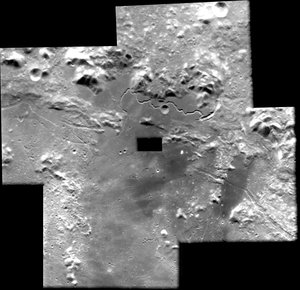Oresme: Signs from the Lunar Heavy Bombardment
This image, taken by the Advanced Moon Imaging Experiment (AMIE) on board ESA's SMART-1 spacecraft, shows the Oresme crater on the Moon.
AMIE obtained this picture on 30 August 2006 - only 4 days before SMART-1’s final impact on the lunar surface. It was taken from a distance of
Oresme is located on the Moon’s far side at 42.3° South and 169° East, measuring 76 kilometres in diameter, north to south. To the northwest, it borders the Mare Ingenii, and to the south-west, the Chrétien crater.
Oresme is framed by a partially bumpy, crooked outer rim, with a flat interior, distinguished from the geological formations outside it. Surrounded by a rough and uneven area, the floor of Oresme is almost a vacant plane, marked only by a few tiny craterlets.
The rim is interrupted twice by other craters: to the southeast by the satellite crater 'Oresme K' and by a smaller one along the northern rim.
Oresme was carved into the surface in early lunar history, approximately four thousand million years ago. Most of the giant impact basins on the Moon were formed during this period, named the Nectarian age. There is a discussion among scientists whether this corresponds to a spike in the Lunar Late Heavy Bombardment or to a monotonic decrease.
“Some theoreticians believe that this bombardment period was caused by comets perturbed by the formation of Uranus and Neptune, while others interpret it as leftover from a population of planet embryos on highly inclined orbits or main belt asteroids” says SMART-1 Project scientist Bernard Foing.
“The lunar surface is a history book where we can study scars from this bombardment. It can teach us not only about the accretion processes that formed rocky planets, but also about the effects of collisions during the period of emergence of life on Earth”.
The crater is named after Nicolas Oresme (1323 -1382), a physicist and astronomer who also had a wide influence as a philosopher and precursor of modern sciences.
Contact information
Bernard H. Foing, ESA SMART-1 Project Scientist
Email: Bernard.Foing@esa.int
Jean-Luc Josset, AMIE Principal Investigator
SPACE-X Space Exploration Institute
Email: jean-luc.josset@space-x.ch















 Germany
Germany
 Austria
Austria
 Belgium
Belgium
 Denmark
Denmark
 Spain
Spain
 Estonia
Estonia
 Finland
Finland
 France
France
 Greece
Greece
 Hungary
Hungary
 Ireland
Ireland
 Italy
Italy
 Luxembourg
Luxembourg
 Norway
Norway
 The Netherlands
The Netherlands
 Poland
Poland
 Portugal
Portugal
 Czechia
Czechia
 Romania
Romania
 United Kingdom
United Kingdom
 Slovenia
Slovenia
 Sweden
Sweden
 Switzerland
Switzerland






































